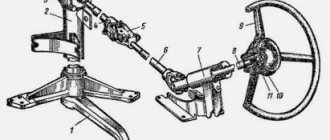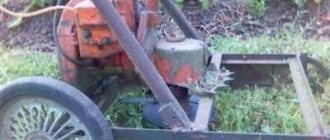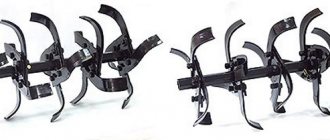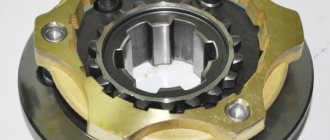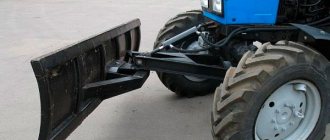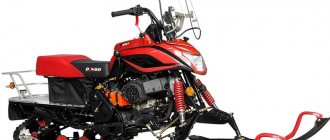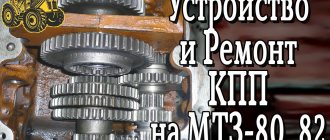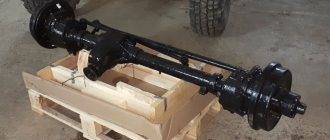PTO tractor MTZ-82 and MTZ-80
The main purpose of this mechanism is to drive active machines that are aggregated with the tractor. Based on their location, the rear and side PTOs are distinguished. Models MTZ 80 and MTZ 82 use a combined power take-off shaft, so it can have either a dependent (or synchronous) or an independent drive.
If the drive is not synchronous, then it is connected to the engine flywheel itself, this will ensure the required rotation speed of the shaft itself, regardless of the speed at which the tractor moves, and whether the clutch is engaged or not. Also, the drive itself can have the following rotation speeds (540 and 1000 rpm) at a crankshaft speed of 2100 rpm.
As for the dependent drive, it is connected to the drive gear of the 2nd stage of the mechanical gearbox, so in this case the frequency will depend and will be 3.5 revolutions per meter of travel.
Related Posts
Why does the clutch break every year on an MTZ 80 with a small cab? I changed the basket, power shaft, bearings in the transmission, flywheel.
Hello guys, I need help, I have an MTZ 80 with a small cab from 1992, I have owned it for 6 years, every six months my clutch, basket and power shaft break, in the first year I changed all the bearings in the transmission, there is no play, but in two I didn’t look, I got a new flywheel for the third year, is it possible that the crankshaft is crooked? The motor runs smoothly without vibration and there is practically no vibration, vibration appears when it comes time to change the disk, basket and power shaft. Thank you in advance.
Installation of a dispenser on MTZ-82 (complete set)
Good day ! I had one question for you guys, we recently installed a dispenser on MTZ 82, bought a complete conversion kit from the store. The tractor driver says that sometimes the steering wheel turns in one direction at idle, but the wheels do not turn, but if you turn slightly in the opposite direction, and then back, the wheels already turn. (he says it doesn’t depend on engine speed). Has anyone encountered such a problem? What to look for the reason? Thank you in advance !
Why is there little release on the paddle release disc on the MTZ 82.1?
Why is there little pressure on the flap release disk on the MTZ 82.1?
MTZ80 converted to MT82 (front drive). Why does it make a lot of noise when the tractor drives at low or high gears?
Hello, good people. Half a year ago I bought an MTZ80 converted to MT82 (front wheel drive). The problem is that when the tractor drives in low and high gears it makes a very loud noise, it’s impossible to drive, and for one thing it infuriates you to the point of horror. The rear axle was dismantled, everything was fine, but alas, the noise remained the same. Noisy: Low 4.5, high speeds 7.8 high speeds. Thank you all in advance!!) I'm waiting for your comments on how to fix it. Thanks in advance.
Why does the MTZ 80 eat the clutch paws? You have to change it every year.
Hi all. The problem on MTZ 80 is eating the clutch paws. You have to change it every year. What could be the problem?
Mtz 82.1 I changed the disc, basket (analogue), release lever - adjusted it according to the book to 28mm. Why is there no clutch? The gap from the presser foot to the release lever is not 3mm.
Great everyone! Clutch. MTZ 82.1 changed the disc, basket (analog), release lever - adjusted it according to the book, rolled it 28mm, assembled it, but there is no clutch. The gap from the paws to the release lever is large and cannot be adjusted by 3mm. I put the disk in, the original basket, the same thing. The distance from the presser foot to the release lever is not 3mm, only 6.7mm. What is the problem, has anyone encountered this problem? Thank you
Why, when you put the new MTZ 82.1 in neutral, release the clutch, vibration starts, press the clutch back and it stops?
Good afternoon. Guys. Tell me, please. On the new MTZ 82.1 you put it in neutral, release the clutch, the vibration starts, press the clutch back and it stops. Why is this so?
Which category belongs to the MTZ 80-82 tractor?
Hello guys, tell me which category belongs to the MTZ 80-82 tractor? I want to unlearn MTZ 80-82, but I don’t know what category it is
Can the clutch drive due to wear on the MTZ 80 power shaft bearing? Either it drives or it doesn’t.
Hi all. Can the clutch drive due to wear on the MTZ 80 power shaft bearing? Either it drives or it doesn’t.
PTO diagram of MTZ 80 and 82
Below we present a diagram of the drive of the rear power take-off shaft for tractors of the MTZ 80 and 82 models, and we will give its explanation.
The main mechanisms of the rear PTO include: 2-speed gearbox, drive type switch, mechanical gearbox, dependent or independent type switch.
The rotation speed of the independent power take-off shaft is switched using a clutch (5), which is installed on the shaft spline (6). And the mechanism that is responsible for this is a hexagon, it is located in the lower cover of the one-piece clutch housing.
The drive is set by switching the claw coupling of the shaft (11) using a lever (18), it is located on the floor of the cabin.
The lever (18) has 3 positions: clockwise rotation - dependent type, anti-clockwise - independent, middle position - neutral. Remember that the synchronous type should only be turned on when the engine is not running or the minimum crankshaft rotation speed, but the synchronous type only when the tractor is stopped.
Planetary PTO gearbox MTZ 82 and 80
This mechanism is one of the important components, so we will dwell on its design in more detail.
this mechanism is designed to control the power take-off shaft and has a gear ratio of 1.47. Its components: drive crown (17), satellites (18), sun gear (19). The satellites are installed on the axles (16), which are pressed into the carrier bore.
On special order, the plant can produce the shaft (15) as a composite one, i.e. special shanks (25) with 8 (for 540 rpm) or 21 (for 1000 rpm) splines can be inserted into its rear end for various implements.
The planetary gearbox itself controls two band-type brakes.
As you can see, the diagram is quite simple to understand.
Side take-off shaft for models 80 and 82
Below is a diagram of the side power take-off shaft for these tractor models.
In this case, everything is even simpler, the drive is carried out through a movable gear wheel (2), and the gear itself moves along the splines using a driver (6). The side shaft can only be engaged when the clutch is disengaged using rod 3.
PTO repair for models MTZ-82 and MTZ-80
One of the main problems is sticking of the shaft control lever or difficult control of the clutch driver when switching modes. Most likely, this is a malfunction of the reinforcement mechanism (spring cup) and wear of the claw coupling. To accurately determine the breakdown, it is necessary to remove and disassemble it.
During disassembly, you must be careful and perform it strictly in a certain sequence. First, you need to move the power take-off shaft control lever to a position where the technological holes in the shift shaft lever (5) and the rear axle shift. Then the locknut (3) must be loosened and the adjusting bolt (2) must be screwed all the way into the roller shift lever, and the locking bolt (4) into the cup.
After making sure that it is well fixed, remove the glass assembly. Then we clamp it under a press and turn out the bolt (4). We replace all faulty mechanisms.
If the dog clutch is faulty, then it is necessary to disconnect the gearbox from the rear axle and replace the parts.
We adjust the tension of the tapes and the lever according to the diagram below.
Need help with MTZ Incomprehensible knocking
Questions can only be asked after registration. Please login or register.
Greetings. This is my first time doing this, but there’s no help to come from. At my new job, they gave me 82 “out of the blue.” The old driver drove with a knock, everything suited him, then he stood for a long time. The knock is incomprehensible. The work was done as follows: replaced the liners (I did not remove the engine 5 main and did not touch the half rings), the piston is old, the rings were replaced (the gap is normal at the rings, the piston did not dangle on the skirt, there are no scratches, the sleeve does not take the nail). I disassembled the head completely down to the bolt, it stood open. I washed all the channels, valves and replaced the springs, the guides are without seals and everything is level. They gave the fuel injection pump a new one, changed and adjusted the nozzles (previously they sorted it out for forty-ones, apparently without any problems). The main problem is that the tractor runs smoothly at idle. There is no knocking noise when picking up speed. As it resets, there is a knocking sound from one pot (as if the valve is catching up). I removed the piston head and cleaned the valves. On the 4th pot I found a bent rod on the suction (I missed it, I was in a hurry). When it started, the knocking did not go away. While it was running, I unscrewed the injector tubes. Only on pot 4, when the tube is unscrewed, this knock disappears. I swapped the injectors here and there to no avail. I removed the piston, found a similar one in the warehouse with a finger, and changed everything by. The knock was in 4. All that is available I did it in a short time. Now the question is: who could tell me where to go from the beginning. In the timing gears, look at the flywheel (judging by your forum, the bolts sometimes loosen), change the connecting rod (Although the pin had no play except for the working one) or something with the camshaft (fuels, glasses). Or is it still a matter of the new injection pump, although it is new in appearance (well, the USSR is worn out there :) somewhere from old stocks.)
Guys, please give me some advice. Simply removing the head and tray 9 times in a week is already too much. Yes, I don’t have enough experience at 25. Maybe I wrote something like that somewhere, just as I learned.
Gap at MTZ: repair and installation
The clutch spacer or housing is the part of the transmission responsible for transmitting torque from the engine to the gearbox and dividing it into two streams. One flow is directed to the chassis, the second to the PTO (power take-off shaft), which, in turn, transmits rotation to the attachment. Installed on tractors, heavy-duty walk-behind tractors and some trucks. It is missing on a number of older tractor models. It may also be absent on some mini-tractors, but for such powerful tractors as the MTZ 82, the gap is necessary. It is this unit that makes the tractor a multifunctional machine capable of working with additional equipment.
Node device
The spacing layout is simple and reliable, like most tractor units. The unit body consists of four compartments. Three of them are lubricated, the fourth is dry, isolated from lubricant by seals.
The dry compartment contains:
- clutch mechanism (disconnects the engine when changing gears);
- shutdown drive connected to a control pedal located in the cabin.
The lubricated compartments contain:
- driving and driven shafts of an independent PTO, equipped with a gearbox and shift drive;
- Hydraulic pump idler gear;
- the brake, which ensures that the input shaft stops when the clutch is depressed, is connected to the control pedal;
- reduction gear.
The operating principle is as follows. The drive power shaft transmits torque to the reduction gear and then to the input shaft of the box. Then the driven shaft of the PTO receives rotation - a special gear block is responsible for this - and transmits it to the intermediate shaft of the box. Next, the claw coupling receives rotation, which ensures switching of PTO modes. Thus, both the wheels and additional equipment receive rotation.
Most common faults
The correct operation of all transmission components depends on the serviceability of the gap mechanisms. If any problems arise in the operation of the gearbox or PTO, experienced tractor drivers look at this unit first.
Most often, disassembling the MTZ 82 gap reveals the following malfunctions:
- Worn main oil seal on the input shaft. Lubricant gets between the flywheel and the driven movable disk, and the clutch linings slip.
- Failure or failure to adjust the clutch brake. Leads to failure of the transmission input shaft braking and to difficult gear shifting, often accompanied by grinding noise.
- Wear of support bearings of PTO drive shafts. Leads to accelerated wear of parts, the appearance of hum and beating, as well as disabling the PTO.
- Wear of seals and seals. Leads to leakage of transmission oil from the housing at intervals.
- Violation of the tightness of the connection between the dry and lubricated compartments. Leads to oil getting on the friction discs and, subsequently, to slipping.
- Incorrect installation of gaps during previous repairs. It is important to ensure that the lower shafts of the PTO and gearbox do not rest against the spline. Otherwise, there will be excess longitudinal force on the shaft, which will lead to displacement of the oil seal, support cover, and, ultimately, to oil leakage.
Repair gaps at MTZ
One of the most persistent traditions of the Soviet automobile industry was the simplification of designs in order to make repairs accessible even in the field. However, this did not apply to all components and mechanisms. There are subtleties in how to disassemble the MTZ 82 gap.
Before starting any work related to removing the clutch, marks should be placed on the housing and pressure plates in order to record the relative positions of the parts and, therefore, maintain the original balancing of the mechanism. Marks can be made with a marker or paint.
Immediately before removing the clutch, you need to tighten the technological bolts into the flywheel. This will provide initial compression to the compression springs. After this, you can unscrew the mounting bolts of the support disk, and then the technological ones. To disassemble the clutch, use a special tool - a two-jaw puller.
Let's look at the main faults and how to fix them.
Problem No. 1: Transmission hum and beating. It is associated with wear of the bearings, which, in turn, appears with an increase in backlash in the supports and gaps in the engagement of the gear units of the gearbox and splined joints.
Do-it-yourself repair of MTZ-80(82). Part 2
Tell me how to regulate the engagement of a vertical shaft with a horizontal one, final drives in the MTZ-82 FDA. And is the king pin pipe of the old and new type interchangeable? Continuation of the topic Repairing MTZ-80(82) with your own hands https://fermer.ru/node/51831. Please continue the conversation here. Old thread will be archived
Guys, tell me what to do so that they can’t start the tractor. The thing is, when I go on vacation, they take my tractor, because they have their own. I’m tired of swearing and the engineer says don’t be sorry, damn, I’m sorry, they broke off one or the other, once it came to a fight, a fight, it’s worth launching, don’t offer an excuse about the launcher, I did it and blocked the magneto and cut off the air, what can be done like that so that they don’t start the diesel engine, but don’t disassemble anything so that they come and clean it up and start it,
I'm tired of swearing and the engineer says don't be sorry
Fuck the engineer. Let him twist the nuts himself at least once.
tell me where this valve is on the injection pump,
The valve on the injection pump is worth draining the return line from the injection pump. On old tractors the tube went to the pump to a double fitting, on the new one the return flow from this valve goes directly to the tank fitting with a turnkey 19 and there is a plug CL14 in it. There is a spring and a ball under it. There will be no pressure. in the filters, the tractor won’t start, no matter how much you pump it, it won’t pump it. But over time, they’ll figure it out and they’ll screw it on from another tractor or from a Kamaz truck, there’s the same one.
on the boost pump, unscrew the large plug (the key is probably 32), take out the spring and screw it back, this will be the fastest. I tried with the valve, but the tractor still started, maybe under load it wouldn’t have worked, but I didn’t try
Interval MTZ 82: device, diagram, disassembly
The transmission of the MTZ 82(80) tractor ensures the distribution of torque from the machine engine to the drive axles and additional equipment of the machine, as well as to the power take-off points. The system of MTZ 82 components includes: an engine clutch mechanism, a tractor gearbox, rear and front drive axles, and an integrated power take-off mechanism. An integral part of the MTZ 82(80) transmission is its intermediate part, located between the engine and the gearbox.
"Gap" or "gap" in the MTZ 82(80) transmission
The gap is a part of the transmission that performs the function of transmitting rotation from the engine through the clutch to the gearbox and dividing the torque into the flow for the chassis and the tractor power take-off shaft. The unit body consists of one dry and three lubricated compartments separated by partitions. The dry clutch compartment is insulated with oil-resistant seals.
The dry compartment includes:
- clutch mechanism
- clutch release drive with release bearing connected to the control pedal
The clutch mechanism is designed to briefly disconnect the diesel engine and transmission in the event of shifting or disengaging gears when changing operating modes.
The three oil lubricated compartments include:
- Power drive shaft and driven shafts of independent PTO with two-speed gearbox and shift drive
- Hydraulic pump drive intermediate gear
- A brake mechanism connected through a system of levers to the clutch control pedal, which ensures that the input shaft stops when the clutch is disengaged.
- Reduction gearbox with shift drive
Torque is transmitted to the tractor gearbox from the power drive shaft through a reduction gearbox to the input shaft of the box. The driven PTO shaft receives rotation from the drive power shaft through the gear block and transmits rotation through the tubular intermediate shaft of the box and further to the cam clutch for switching PTO modes.
MTZ tractor transmission: design of components and repair methods
A transmission is an essential part of wheeled vehicles that is powered by an internal combustion engine. MTZ tractors are no exception.
The transmission consists of numerous components and mechanisms that are connected into one set, consisting of a car engine with a wheelbase.
This also includes a number of additional components that ensure stable operation of the entire system.
The transmission design includes:
- checkpoint;
- brake for gearbox;
- transfer case;
- clutch;
- clutch system;
- brake system;
- drive pulley;
- differential;
- driving front axle;
- cardan drive;
- creeper;
- rear and side PTOs.
There are also bearings and gears, other types of shafts, rollers, ball joints, bushings, and so on. The transmission includes a huge number of components assembled into one system responsible for control. In this case, the nodes themselves are regulated separately.
Gearbox on MTZ wheeled and tracked tractors: operating principle and design elements
The gearbox is one of the most important components. It is designed to change the speed of the tractor.
Capable of switching the machine to drive backwards and putting attachments into operation through the side power take-off shaft.
The standard gearbox has the following configuration: nine steps for moving forward, and two more for moving in reverse.
The number of gears for forward and reverse is increased due to the reduction gearbox. For example, for forward movement there are 18 steps, for reverse it is equal to four. The creeper is an additional equipment for moving at low speeds; it can be equipped with any standard box.
Creeper for MTZ-80/82 tractors
This is relevant for those who often perform tasks at slower than standard speeds.
About the gearbox design
The primary and secondary shafts will have a uniaxial placement, if you look at the gearbox in cross-section, along a straight axis. The intermediate shaft is located parallel to the primary one.
The shafts of first gear and reverse gear belong to the same part. The front end is fixed to the input shaft in the bearing, in the gearbox housing housing.
At the end in the bearing the rear and front ends are connected to each other at the input shaft.
Gearbox MTZ-50
The 3rd, 4th and 5th gear drive gears are mounted on the input shaft splines. The reduction gearbox is mounted on the input shaft through the driven gear.
The intermediate hollow shaft is equipped with splines on which the driven gears are located at the switch responsible for 3rd, 4th and 5th gears.
There is an intermediate gear between the driven gear in third gear and the intermediate gear.
About the intermediate shaft
The shaft rotates on ball bearings on the bushing. There is a strong connection between the second stage main gear and the bushing. A plus to the design is the shaft inside, which has a supporting sleeve. The cams of the rear synchronous shaft, responsible for power take-off, are located at the rear of the gear.
Above the main gear is an impeller that sprays oil onto the active parts of the gearbox.
About the gearbox
A two-stage gearbox is included with all standard gearboxes. It has its own scheme of work with certain features.
The first stage is responsible for engaging 1st, 2nd, 3rd, 4th and 5th gears. This is for driving in front, and for driving in reverse, only one gear is engaged. The second gear stage is responsible for engaging the remaining gears.
To turn on the first stage of the gearbox, you need to engage the drive gear of the first stage and the outer ring, which is located at the secondary shaft. The second stage gearbox works slightly differently: it engages the first stage main gear, which meshes with the ring gear from the second stage.
Also read: Design features and technical characteristics of MTZ crawler tractors
About the clutch system on the tractor
This system is located on a special flywheel, between the gearbox and the engine. The clutch on the tractor performs the following tasks:
- Reliable transmission of torque to the engine from the transmission.
- Helps briefly disconnect the engine from the transmission when shifting gears. There are usually no shock loads.
- To smoothly connect the stationary input shaft of the transmission to the crankshaft of the engine, which is constantly rotating. These components load smoothly thanks to the clutch - without the need to stop the engine.
- Protection against sudden loads for transmission and engine.
- To make it easy to stop the tractor for short periods of time while working.
Malfunctions and repair gaps
The main list of malfunctions leading to stopping the operation of the tractor and subsequent disassembly and repair of mechanisms at intervals:
- Sometimes clutch linings slip when the main oil seal on the input shaft wears out. Oil flows between the flywheel and the driven movable disk.
- There is no braking of the gearbox input shaft. Shifting gears is difficult or makes a grinding noise. Adjust or replace the clutch brake.
- Spontaneous shutdown of the independent PTO rotation speed
- Transmission oil leaks from the housing at intervals.
The overall operation of the unit depends on the condition of the support bearings of the drive power and driven PTO shafts. Due to the increase in play in the supports, the gaps in the engagement of gear blocks of the gearbox and splined joints increase, which leads to increased wear of parts, the appearance of a hum, beating during operation, and spontaneous knocking out of the PTO speed position.
To replace support bearings, shafts and gears in between, complete dismantling of the unit is required, followed by disassembly and replacement of worn parts.
Replacing oil seals in between
To replace the oil seals on the shaft supports in the front partition of the housing, the gaps on the power shaft, the driven PTO shaft and the hydraulic system pump drive axis, the following steps must be performed:
- We remove the hood.
- Disconnect the transfer case driveshaft.
- Unscrew the nuts securing the unit with the motor.
- Using the front wheels, we roll the engine away from the gap.
- Remove the lifting mechanism with the bracket.
- We change the seals.
- We collect cuttings.
- We roll up the tractor.
- We fasten the gap.
- Install the hood.
In the upper front support of the pump drive axis, the rubber sealing ring is replaced. The fixing bolt is unscrewed from the axle. Then remove the bushing and replace the o-ring. If the bushing and seat are broken, grind a new one of a larger size.
In the middle front support between the power shaft and the PTO drive shaft, the oil seal is replaced, clamped by a sleeve and a bushing.
The lower support is sealed with an oil seal and closed with a cup-shaped cover with four bolts.
Repair practitioners pay attention! When installing the gaps with the gearbox, before tightening the fastening bolts, you need to make sure that the splined connections of the lower shafts of the PTO gaps and gearbox do not rest against the spline. This will not create a longitudinal force on the shaft, which, when tightening the units, will squeeze out the oil seal and the shaft support cover, and will not lead to oil leakage.
The tightness of the seals between the dry clutch compartment and the lubricated part of the gap ensures the tightness of the general lubrication system of the tractor transmission and isolates the clutch friction discs from oil, which causes slipping.
Repair of the drive and speed change gear of the independent PTO
Malfunctions of the unit include knocking out the on position of the PTO rotation speed. One of the reasons is a malfunction of the spring-ball retainer of the fork on the shift axis installed in the lower housing cover.
- Remove the cover with the switching drive
- Disconnect the shift fork and axle, gaining access to the spring-ball retainer
- Inspect or replace parts of the retainer
- Reassemble the axle and fork in reverse order
MTZ-80 When the clutch is pressed, noise starts, the tractor starts moving if there is no heavy load
Questions can only be asked after registration. Please login or register.
When the clutch is pressed, noise begins, the tractor starts to move if there is no heavy load (that is, it does not move with the cultivator lowered). We changed the basket, flywheel, feredo. That maybe they had already completely turned off the PTO because they thought that it was turning the box.
When the clutch is pressed, noise begins, the tractor starts to move if there is no heavy load (that is, it does not move with the cultivator lowered). We changed the basket, flywheel, feredo. That maybe they had already completely turned off the PTO because they thought that it was turning the box.
Hello colleague. Judging by your story, the 210 bearings between the clutch power shaft and the PTO drive shaft could have fallen apart. Accordingly, in this case, the products of destruction of the rear bearing could get between the shafts and make these shafts to some extent one part. In this case, it should be difficult to engage gears. (Gears growl.) Is that so?
The clutch has been adjusted. Everything turns on fine.
When the clutch is pressed, noise begins, the tractor starts to move if there is no heavy load (that is, it does not move with the cultivator lowered). We changed the basket, flywheel, feredo. That maybe they had already completely turned off the PTO because they thought that it was turning the box.
Hello colleague. Judging by your story, the 210 bearings between the clutch power shaft and the PTO drive shaft could have fallen apart. Accordingly, in this case, the products of destruction of the rear bearing could get between the shafts and make these shafts to some extent one part. In this case, it should be difficult to engage gears. (Gears growl.) Is that so?
I turned off the PTO in the gap, that is, the shaft that goes to the PTO is completely disconnected in front of the box.
I turned off the PTO in the gap, that is, the shaft that goes to the PTO is completely disconnected in front of the box.
Great. However, if 210 really fell apart, then this will not help. We are talking about two shafts that go into the clutch basket. One goes into the disc, and the other goes into the basket. Before rolling the tractor, you should have made sure. that they rotate easily and do not touch each other.
Source
